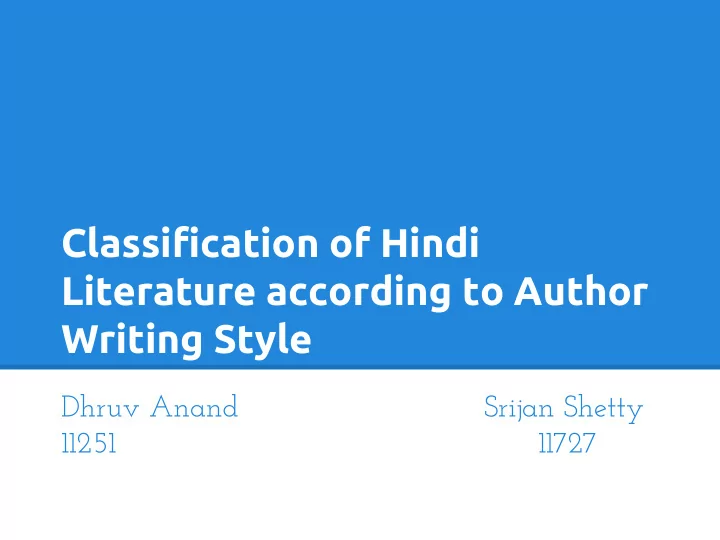

Classification of Hindi Literature according to Author Writing Style Dhruv Anand Srijan Shetty 11251 11727
Motivation ➔ Document Fraud Detection ➔ Classifying works from unknown authors ➔ From a Literary perspective ◆ Repeating trends of authors ◆ Adopting styles of popular authors
Previous Work ➔ Extensive work done on Author Attribution for English (using domain-specific datasets like blogs, emails, forum posts, short stories and novels) ➔ No work has been done on Hindi datasets ➔ Various lexical and syntactic features have been tried by researchers in this field
Challenges ➔ Non-uniform data for Hindi ➔ Variance of writing style markers in Hindi Literature ➔ Multiple derivative words that must be aggregated without any pre-programmed tool for lemmatization. (The language is morphologically rich.)
Problem Statement ➔ Apply known methods of Author Attribution to a Hindi dataset ➔ Analyse difference in effectiveness of various methods between English and Hindi ➔ Exploring new types of lexical and syntactic features to give better results for Hindi Literature
Methodology
Proposed Features ➔ Word n-grams ◆ Stemmed/non-stemmed unigrams ◆ Collocations (bigrams) ➔ Character n-grams ➔ Sentence length distribution ➔ Word length distribution ➔ Feature word frequency distribution
*image from [Sta09]
Classification ➔ Supervised ◆ SVMs ◆ Bayesian Multinomial Regression (BMR) ➔ Unsupervised ◆ K-means clustering
Framework Feature Text Snippets Specification Stage 1 Results Feature Extraction Feature Vectors Label Assignment Stage 2 Stage 3 Classification Evaluation
A bit of theory
Bag of Words http://www.python-course.eu/images/document_representation.png
K Means (http://www.mathworks.com/matlabcentral/fileexchange/screenshots/2240/original.jpg)
SVM http://www.thebookmyproject.com/wp-content/uploads/Intrusion-Detection- Technique-by-using-K-means-Fuzzy-Neural-Network-and-SVM-classifiers.jpg
BMR http://upload.wikimedia.org/math/2/e/e/2eeac600b65d77080381284f530f37d4.png
Where do we stand
Dataset Compilation ➔ No standard dataset for classical/contemporary hindi authors (novels and stories) ➔ Scraped HindiSamay.com manually to build a database of Classical Hindi literature. ◆ 5 authors ◆ 2-4 lakh words per author ➔ Each author’s work has been divided into multiple snippets of 500 words.
Unigrams ➔ Belief: Authors repeat the same set of words ➔ Stemming: BOW using all tokens and BOW using 4500 most frequent words (>20 frequency in the entire corpus) ➔ Classification: K-means on 3 classes (RNT, Premchand, V.N.Rai) and on 5 classes. ➔ Results for 3 classes: ◆ Average Precision: 50% (v/s baseline of 33%) ◆ Average Recall: 48% (v/s baseline of 33%)
Results with 5 authors 0 1 2 3 4 Snippets Precision Recall RNT 111 14 20 0 6 151 22.65% 73.5% Prem 108 21 58 0 211 398 71.77% 53.01% Dharamvir 11 24 14 150 2 201 100% 74.6% Sarat 142 332 3 0 65 542 82.19% 61.25% VN 118 13 277 0 10 418 74.46% 66.26%
Insights ➔ Corpus has mostly stories for Rabindranath Tagore, both recall and precision for him are low indicating that across multiple works frequent words used by author change. ➔ Corpus contained only novels for Premchand and so both recall and precision for him were high > 70% ➔ The corpus contained essays by V.N.Rai, indicating high amount of content words.
Future Work
In the coming weeks ➔ Use collocations (bigrams) to as a feature. ➔ Analyzing sentence structure: ◆ Sentence lengths ◆ Number of subjects, verbs, objects in a sentence (instead of POS tagging we will lookup common words from HindiWordNet) ➔ Reducing dimensionality using PCA. ➔ Training on multiple features together (using multivariate discriminant analysis ) ➔ Improving results by tuning snippet length and parameters used in classification.
In the future ➔ Exploring the possibility of using a morphological tagger to get more accurate style measures for authors. ➔ Extending the method to Hindi tweets, forum comments and messages to compare accuracy.
References
Literature 1. [KSA09] Moshe Koppel, Jonathan Schler, and Shlomo Argamon. Computational methods in authorship attribution. J. Am. Soc. Inf. Sci. Technol., 60(1):9-26, January 2009. 2. [KSA11] Moshe Koppel, Jonathan Schler, and Shlomo Argamon. Authorship attribution in the wild. Lang.Resour. Eval., 45(1):83-94, March 2011. 3. [Sta09] Efstathios Stamatatos. A survey of modern authorship attribution methods. J. Am. Soc. Inf. Sci. Technol., 60(3):538-556, March 2009.
Tools Used ➔ ZSH ➔ Python Modules ◆ indicngram ◆ nltk, scipy, scikit-learn ➔ Snippets of code have been taken from ◆ http://www.csc.villanova. edu/~matuszek/spring2012/snippets.html *www.python.org
THANK YOU! Questions?
Recommend
More recommend